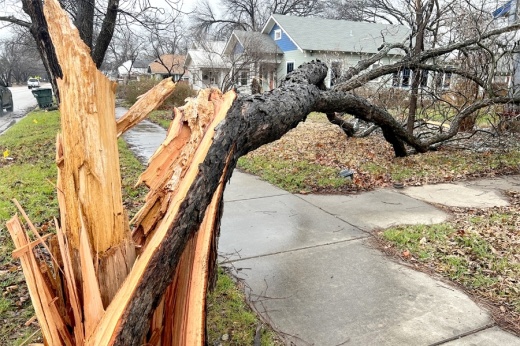Williamson County Judge Bill Gravell issued a disaster declaration Jan. 31, which will allow some people with property damage to receive financial assistance, such as low-interest loans, for those who are uninsured or underinsured.
To be eligible for assistance, the county must meet a minimum threshold for damage as a result of the storm of $2.7 million, and the state must have a disaster declaration and meet a minimum threshold of $51.7 million. Gov. Greg Abbott issued a declaration for Texas on Feb. 4.
As of Feb. 6, county residents had reported $2.5 million in damages, said Michael Shoe, Williamson County Emergency Management director. Shoe said the county expects that number to increase as residents continue to clean up following the storm.
“This, in its own way, is the widest-spread, biggest disaster I’ve ever seen hit the county,” Williamson County Precinct 4 Commissioner Russ Boles said. “I have not seen a tree that has not snapped in some form or fashion.”
Scope of the storm
Beginning overnight Jan. 31, freezing rain accumulated on roads, trees and power lines, weighing them down, resulting in thousands of power outages and widespread tree damage.
More tree damage occurred this time because of ongoing drought conditions, Southwestern University Landscape Architect Stephanie Krull said.
“The less water that’s in [a tree], the less flexible it is,” she said. “So when we’re in a drought period, which we are, the trees are a little more stressed than they are when they have regular rainfall.”
Lee Evans, an arborist with Austin-based Certified Arbor Care, said a half inch of ice accumulation on a tree that is 30 inches in diameter at the trunk can weigh about 7,000 pounds, easily causing trees and other infrastructure to fall under the pressure.
Serenada resident Laura Atkinson said a 40-foot tree split in half, damaging her property. Later that night, she woke up to a tree ripping through her 80-year-old neighbor’s ceiling.
“Our neighborhood looks like a disaster zone,” Atkinson said. “We didn’t lose electricity like a lot of people did. We just heard limbs. We have 90 trees in our yard, and we back up to the woods, and we could hear trees falling everywhere.”
Georgetown residents are served by three different electricity providers: Georgetown Utility Systems, Oncor and Pedernales Electric Cooperative, according to the city.
While power outages occurred across all three providers, they were not due to grid conditions or demand outpacing supply like during Winter Storm Uri in 2021, Oncor Area Manager Armando Perez. Perez said Oncor outages in Williamson County peaked at about 31,300 on Feb. 1.
About 3,700 of Georgetown Utility Systems’ 31,730 customers experienced power outages, said General Manager Daniel Bethapudi said.
About 9,000 PEC customers in the city were without power at the peak of outages, according to the company.
“What made this outage restoration particularly challenging was repetitive tree-related damages to the power lines,” Bethapudi said in an email.
Continuing to clean up
With state and local disaster declarations in place, officials are encouraging residents to document and report any damage to their properties to the Texas Division of Emergency Management.
Shoe said the $2.5 million in damages reported already does not include the county’s own expenses or expected reports from other area cities and school districts.
“So we’re very confident we’ll get way over the disaster threshold,” Shoe said. “As long as the state meets the $51.7 million disaster threshold, we’ll start to see reimbursement.”
Locally, residents are responsible for removing trees and limbs from their personal property, according to city and county officials.
City and some municipal utility district residents are able to place tree limbs and debris by the curb for pickup on the first recycling day of the month. Additionally, a special pickup event will take place the week of Feb. 27.
Residents can also drop off unlimited tree debris at 1111 N. College St. from 8 a.m.-5 p.m. Feb. 16-18 and Feb. 23-25.
Residents of the extraterritorial jurisdiction can hire a private hauler or bring waste to the Transfer Station; however, there are costs and weight restrictions, according to the city.
Meanwhile, county crews have been working to open its over 1,500-mile road system but have not been able to dispose of brush found in the right of way. Robert Daigh, the county’s senior director of infrastructure, said the county does not have the workforce or time to clean up the debris.
“It will take a significant effort and significant amount of time—as in months to a year—to pick up the debris,” Daigh said.
County commissioners said the court will work with roads staff to hire a disposal services company to help remove the debris around the county.
Despite the nature of the storm, Georgetown ISD facilities did not sustain any damage, said Melinda Brasher, executive director for communications and community engagement, in an email. The district was closed from Jan. 31-Feb. 2 and opened on a two-hour delay Feb. 3.
Brasher said the district has enough minutes built into its instructional calendar to cover two missed days. Additionally, she said the Texas Education Agency may give waivers to districts in areas with a disaster declaration like it did for Winter Storm Uri.
Moving forward, Krull said the best way to protect trees is to regularly prune branches and deep-water trees three times a year.
"I’m not disappointed in my neighbors and the people of Georgetown,” Georgetown resident Cathy Robbins said. “I keep seeing all these young people picking up branches [and] cutting things up for people. I think that’s a wonderful, wonderful example of the kind of community we have.”
Disposing of debris
Local officials said it will take weeks and even months to clean up all the debris left from the winter storm that moved through the area Jan. 31-Feb. 2. Both the city of Georgetown and Williamson County are offering options to help residents clear downed trees and brush from their yards.
Residents can place bundled tree limbs and debris by the curb, which will be picked up on the first recycling day of the month.
Those who missed the February pickup may leave limbs out until the March pickup. A special pickup event will take place the week of Feb. 27. Residents can place uncut and unbundled tree branches at the curb by Feb. 26. Residents and businesses can also drop off storm debris at the Georgetown Transfer Station at 250 W.D. Waldon Drive; Organics By Gosh, 2040 FM 969; or the Killeen Transfer Station, 12200 Hwy. 195.
Reporting damage
To qualify for additional aid, the city and state must have incurred a specific amount of storm-related damages. Residents and business owners are encouraged to report damage to personal property to the Texas Division of Emergency Management.







